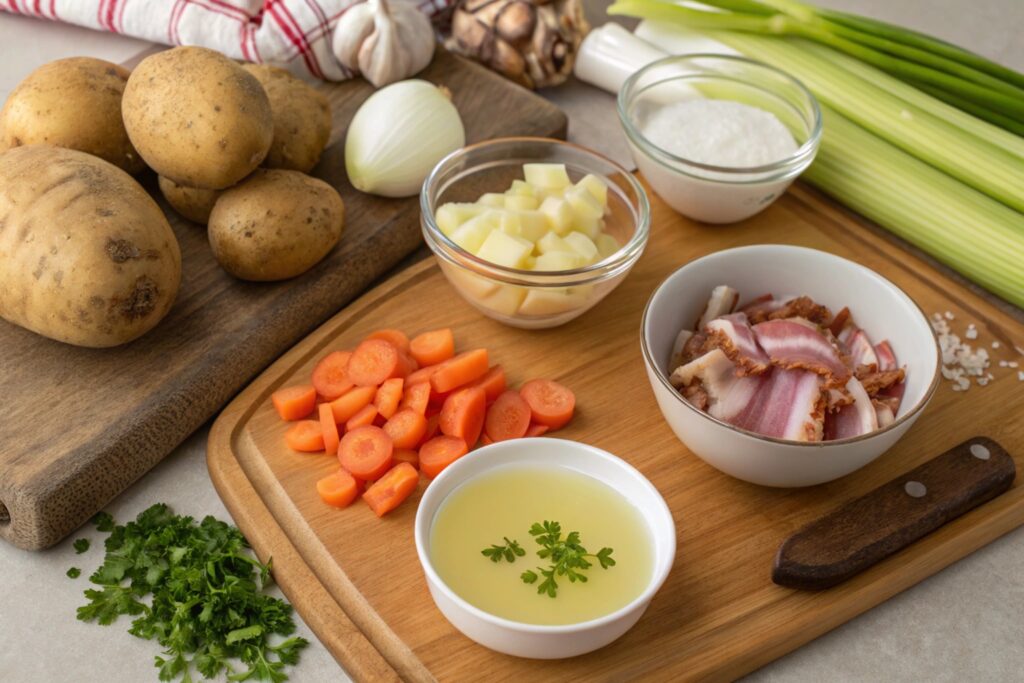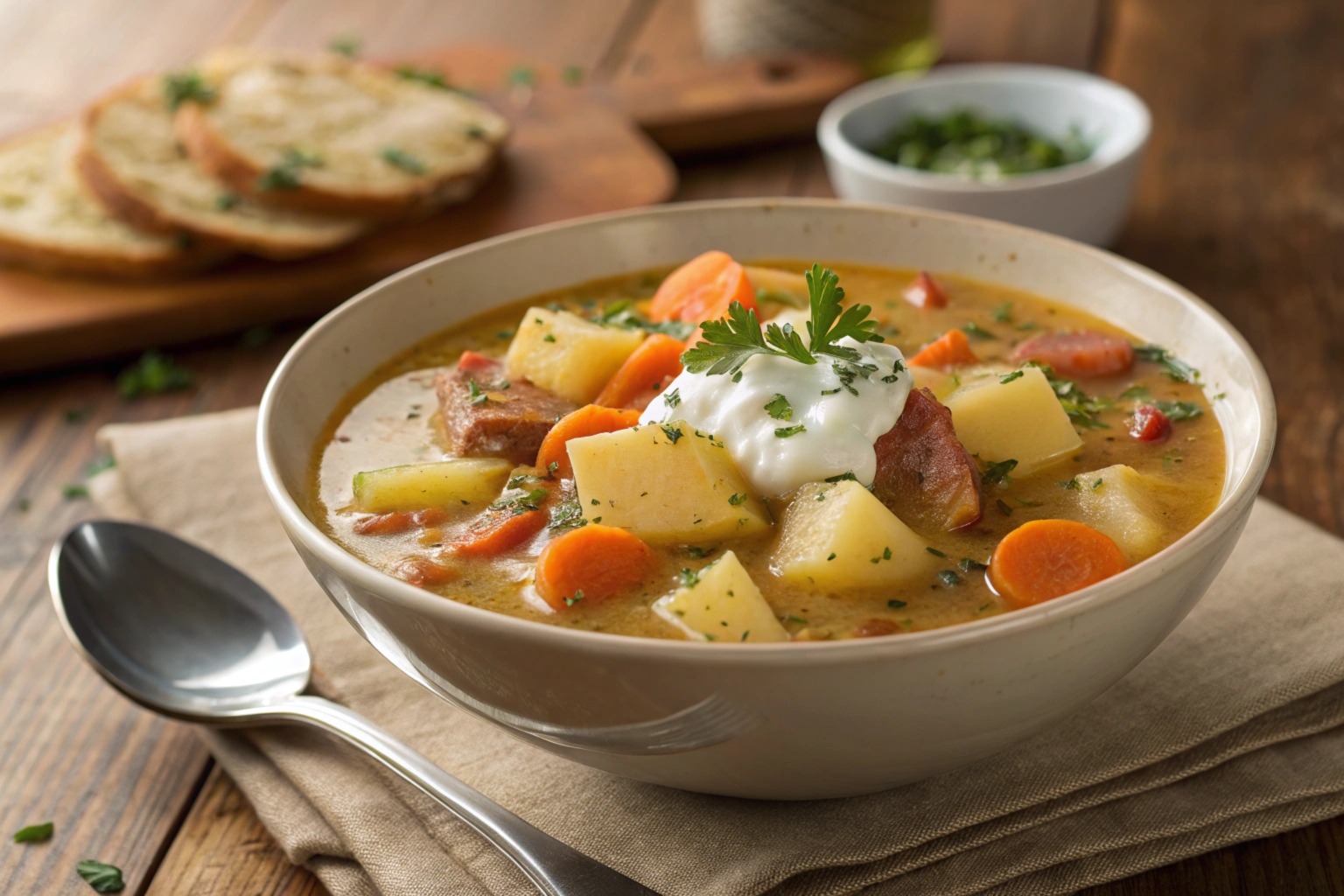Origins of German Potato Soup
German potato soup, or Kartoffelsuppe, is a comforting dish deeply rooted in German culinary traditions. Originating as a humble peasant meal, this soup was created using affordable and accessible ingredients, particularly potatoes, which became a staple in European diets during the 18th century. German potato soup was often prepared to warm families during the cold winter months, providing a hearty and nutritious option for rural communities. Over time, the recipe evolved, incorporating regional flavors and ingredients such as sausages, root vegetables, and fresh parsley, making it a versatile and beloved dish across Germany.
This hearty soup represents more than just sustenance; it embodies the simplicity and ingenuity of German cuisine. Many variations exist, from the creamy, smooth versions to chunkier, rustic styles, each reflecting the culinary preferences of different regions. Whether you’re savoring a bowl of traditional Bremer Kartoffelsuppe or enjoying Bunte Kartoffelsuppe with vibrant vegetables, German potato soup offers a delicious glimpse into the country’s rich gastronomic heritage.
Key Ingredients
The ingredients in German potato soup are simple yet packed with flavor. Each component contributes to the dish’s hearty texture and savory taste.
Potatoes
Potatoes are the backbone of the soup, lending a creamy texture and mild flavor. Yukon Gold potatoes are a popular choice for their buttery taste and ability to hold their shape during cooking. For chunkier soups, russet potatoes work well, while a combination of varieties can add depth to the dish.
Leeks
Leeks bring a mild, sweet onion flavor that complements the soup’s savory profile. Their delicate taste enhances the broth without overpowering the other ingredients. When preparing leeks, use the white and light green parts, slicing them thinly for even cooking.
Celery Root
Celery root, or Knollensellerie, adds an earthy and slightly nutty flavor. This underrated root vegetable also contributes to the soup’s creamy consistency when blended. If celery root isn’t available, celery stalks can be substituted for a similar aromatic touch.
Optional Add-ins (Sausages or Bacon)
Traditional recipes often feature sausages such as Vienna sausages (Wiener Würstchen) or pork sausage slices for a smoky, savory element. Bacon bits or pieces fried in their own fat provide a rich depth of flavor. For plant-based versions, consider adding vegan sausages or smoked tofu.
Cooking Methods
Creating German potato soup requires attention to both preparation and cooking techniques to achieve its signature creamy and flavorful profile.
Preparation Steps
Start by washing and peeling the potatoes, then dice them into evenly sized chunks. Chop the leeks, celery root, and other vegetables into uniform pieces to ensure consistent cooking. If you’re including sausages or bacon, slice them into bite-sized pieces for easy incorporation into the soup.
Cooking Techniques
- Sautéing Aromatics: Heat a soup pot over medium heat and sauté chopped onions, garlic cloves, and leeks in a bit of oil or bacon fat until softened. This step enhances the soup’s allium flavor.
- Simmering: Add the potatoes, celery root, and soup greens to the pot, followed by vegetable stock or chicken stock. Season with salt, black pepper, and optional spices like ground nutmeg or cumin. Simmer on medium-low heat for 30-40 minutes until the vegetables are tender.
- Blending: Use an immersion blender to achieve a creamy texture, or leave the soup chunky for a rustic feel. For a smoother consistency, transfer soup to a regular blender in batches.
- Final Touches: Stir in heavy cream, dairy-free cream, or cashew cream for richness. Add sausage slices or bacon pieces, and let the soup simmer for an additional 3-4 minutes to infuse the flavors.
Variations of German Potato Soup

Vegetarian Options
Vegetarian potato soup can be just as hearty and flavorful. Replace chicken stock with vegetable broth, and skip the meat add-ins. Incorporate additional root vegetables like carrots and parsley root for enhanced depth. A dollop of sour cream or oat cream can add creaminess without the need for dairy.
Traditional Recipes
Traditional recipes focus on simple, wholesome ingredients. Classic Kartoffelsuppe mit Wiener Würstchen features Vienna sausages, while other versions might include celery plant and classic Suppengrün ingredients like carrots, leeks, and parsley root. Traditional recipes often call for a potato masher instead of a blender, maintaining the soup’s rustic character.
These recipes often maintain a rustic character, similar to other wholesome meals like the Cottage Cheese Flatbread.
Tips for Serving
German potato soup is best served piping hot, garnished with fresh parsley or green onions for a burst of freshness. Pair it with crusty bread, such as sourdough or traditional German rolls, to soak up the rich broth. For an extra touch, sprinkle with black pepper or lemon zest before serving.
Bowls of soup can be portioned into individual servings or ladled directly from the pot for family-style dining. If you’re hosting a gathering, consider placing a printable recipe card nearby, inviting guests to recreate the dish at home.
Nutritional Benefits
This soup is not only delicious but also nutritious, thanks to its wholesome ingredients. Potatoes provide complex carbohydrates and potassium, while leeks and celery root are rich in vitamins and antioxidants. Using vegetable broth keeps the dish low in fat, while optional add-ins like sausages or cream can increase the calorie content for those seeking a heartier meal.
For a lighter version, opt for plant-based milk or skip the cream altogether. Adding more vegetables like carrots, parsley root, and celery plant enhances the soup’s fiber and nutrient profile.
Rich in Vitamins and Minerals
German Potato Soup is primarily made from potatoes and a mix of root vegetables such as turnips and parsnips. These vegetables are excellent sources of essential vitamins and minerals:
- Potatoes: Loaded with Vitamin C, Vitamin B6, and potassium, potatoes support immune function, help in the formation of red blood cells, and aid in muscle contractions.
- Root Vegetables: Turnips and parsnips provide a good dose of dietary fiber, which promotes digestive health, as well as folate and other B vitamins that support energy metabolism.
Heart Health
The inclusion of ingredients like bacon and sausage provides protein, but it’s important to consume these in moderation. By incorporating lean cuts and balancing them with nutrient-dense vegetables, you can make the soup heart-healthy. The healthy fats present in the soup (especially if using olive oil or low-fat dairy) may contribute to heart health. Additionally, the potassium from potatoes can help manage blood pressure levels.
Digestive Benefits
The fiber content in this soup, primarily from the vegetables, aids in digestion. A diet high in fiber is known to prevent constipation and improve gut health. The soluble fiber found in potatoes also helps regulate blood sugar levels and supports a healthy microbiome.
Anti-Inflammatory Properties
The nutrients in German Potato Soup may also provide anti-inflammatory benefits. Ingredients like nutmeg, often used as a seasoning, are known for their anti-inflammatory properties. This can be particularly beneficial for those looking to reduce inflammation in the body, which is linked to various chronic diseases.
Balanced Macronutrients
Each serving of German Potato Soup provides a balanced mix of macronutrients:
- Carbohydrates: The soup is primarily carbohydrate-based, making it a great source of energy.
- Protein: With a modest amount of protein from the bacon, sausage, and the vegetables, it helps in muscle repair and growth.
- Fats: Healthy fats from the added ingredients contribute to satiety and flavor.
For more nutrient-packed meal ideas, explore recipes like Apple Pie Overnight Oats.
Storage Techniques
Leftover soup can be stored in an airtight container in the refrigerator for up to three days. To reheat, transfer the soup into a pot and warm it over medium heat, stirring occasionally. For freezer storage, let the soup cool completely before portioning it into freezer-safe containers. When reheating frozen soup, thaw it overnight in the refrigerator and reheat on the stovetop.
Avoid freezing soups that contain dairy-based cream, as they may separate upon thawing. For dairy-free versions, cashew or oat cream holds up better during freezing. Whether refrigerated or frozen, a quick garnish of fresh parsley or a ladle of soup broth can revive the flavors when serving.
German potato soup is a timeless classic that captures the heart of traditional German cuisine. With its comforting flavors, nutritious ingredients, and endless variations, it’s no wonder this dish remains a favorite soup around the world. From the rustic charm of chunky potato soup to the creamy elegance of blended versions, there’s a recipe for every palate. Serve it with fresh bread and enjoy the savory flavor of this beloved German dish.


6 thoughts on “A Step-by-Step Guide to Perfecting Traditional German Potato Soup”